Global Health

No look ahead at women’s health issues in 2022 would be complete without a discussion of the
continuing impact of the COVID-19 pandemic. COVID-19 death rates are significantly higher among men, but—for reasons experts are still trying to understand—women are as much as four times as likely to suffer from “long COVID,” with symptoms such as fatigue, insomnia, and cognitive dysfunction persisting after the infection has resolved.
Available evidence suggests that women’s emotional well-being has also taken a bigger hit from COVID-19. In a survey by the international humanitarian organization CARE, 27% of women reported pandemic-related mental health challenges such as anxiety, loss of appetite, and inability to sleep, compared to 10% of men. Women’s health advocates attribute this to women’s outsized role as unpaid caregivers for sick family members as well as children forced to stay home due to school closures. Women also make up 70% of the frontline healthcare workforce, which has consistently reported highly elevated levels of stress and burnout throughout the pandemic.
COVID-19 has not only negatively impacted women’s health and well-being worldwide, it has also stalled progress on a number of women’s health initiatives. However, with global public health authorities hopeful that COVID-19 will at least partially recede as a global health emergency in 2022, look for several issues to come to the forefront once again.
Sexual and Reproductive Health Efforts Will Be Renewed
The United Nations Population Fund estimated in April 2021 that a disruption in contraceptive services due to the pandemic had resulted in 1.7 million unintended pregnancies worldwide. One study revealed significant increases in maternal death, stillbirth, and maternal depression globally, citing limited access to maternal services and reduced healthcare-seeking behavior as major contributing factors, especially in low- and middle-income countries.
The issue took center stage in mid-2021 at the UN-organized Generation Equality Forum, where participants pledged a cumulative $40 billion to accelerate gender equality efforts in the face of COVID-19 setbacks. That included $1.4 billion from the Gates Foundation, $1.2 billion from the government of Norway, and $83 million from the Ford Foundation to boost sexual and reproductive health efforts worldwide.
The infusion is expected to jump-start Generation Equality’s efforts toward its stated five-year goal of delivering quality sexuality education to 50 million additional adolescents, providing access to contraceptive services to 50 million more women, integrating comprehensive sexual and reproductive health access into health systems in 20 additional countries, and advancing legal and policy reforms to support sexual and reproductive health access in at least 10 additional countries.
Expect a progress report when many of the organizations at the Generation Equality Forum gather in Kigali, Rwanda, for the Women Deliver conference in 2023.

Many Countries Will Focus on Low Fertility Rates
At the same time, governments around the globe are raising the alarm about dramatically declining fertility rates, which are largely linked to increased educational attainment and access to contraception among women.
According to demographers, the pandemic accelerated a drop in global fertility rates that had already been occurring, and some believe that nearly every country could see shrinking populations by the end of this century. More important, populations are expected to get significantly older, with more people turning 80 than being born in 2100.
Many governments worry that this could dramatically increase the burden on the working-age population to support non-working, older adults, drive up taxation rates, and foster political and social instability.
In 2022, policymakers are expected to place more emphasis on fertility issues in an attempt to bounce back from the pandemic baby bust. Given the parallel efforts being made to increase access to education and contraception for women, however, developing the correct policy responses to low fertility rates will be complex as well as critical.
Some countries have already begun offering housing and childcare subsidies to encourage births, along with requiring employers to offer paid maternity leave and flexible work scheduling. Several governments in Europe and Asia have recently begun subsidizing fertility treatments such as in-vitro fertilization. China’s health commission has set a goal of having at least one institution offering IVF for every 3 million people by 2025.
Cervical Cancer Will Be Targeted for Elimination
Increasingly, advocacy groups are touting women’s health initiatives as important for economic prosperity, enabling women to participate fully in the workforce.
The current global push to prevent and control cervical cancer could serve as a case study for that rationale. Most commonly diagnosed between ages 35 and 44, cervical cancer often strikes women in their prime earning years, as well as during the time that they are most needed as caregivers to children and elderly family members.
Cervical cancer is also highly preventable through vaccination for the human papillomavirus, screenings for early detection, and treatment of precancerous lesions. Though the pandemic sidelined vaccination and screening programs in many countries, look for a comeback in 2022 as these countries aim to meet the UN’s targets for the elimination of cervical cancer by 2030.